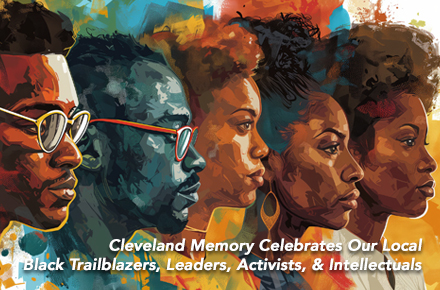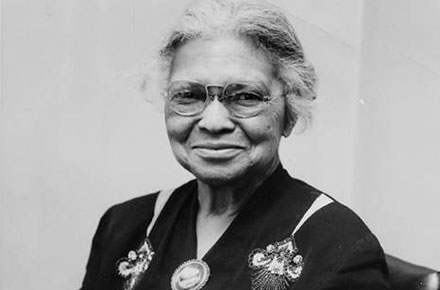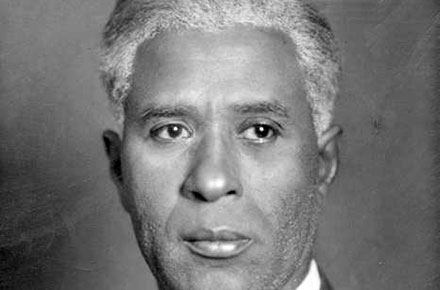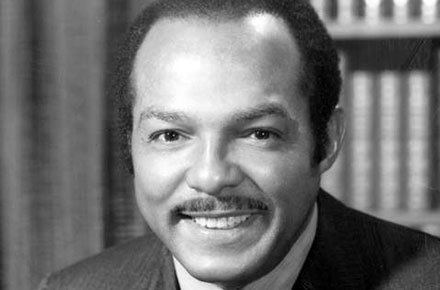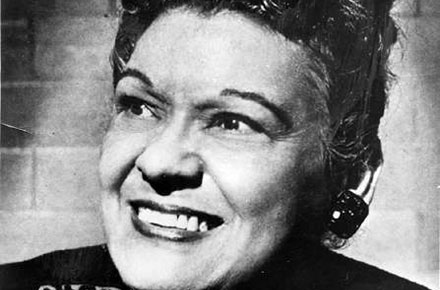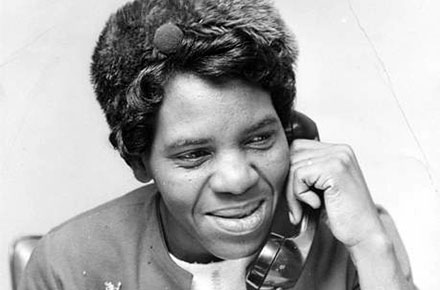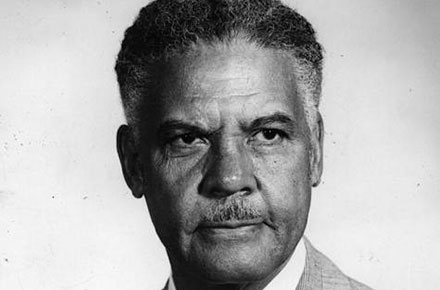Black Trailblazers, Leaders, Activists, and Intellectuals in Cleveland
a pathfinder to Black local history
Historical Photos from Cleveland Memory
Black Trailblazers, Leaders, Activists, and Intellectuals in Cleveland began as a showcase of historical photographs of individuals, titled Notable Blacks of Cleveland. Images of some 500 people were selected from the photographs in the Cleveland Press Collection and became one of our first Cleveland Memory exhibits. Read more about our historical images...
Providing context to these pictures through articles, e-books, audio interviews, speeches, and oral histories enables us to describe a broader story of half the city's population. We have added much content to our collections and to Cleveland Memory over the years, as have our partners and colleagues across the region. While this site cannot attempt to serve as a comprehensive history of the Black experience in Cleveland, Ohio, we are happy to offer a sampling of materials that collectively tell a broader story about African American life in Cleveland, Ohio. We invite you to explore, and to share your favorite sites for us to add to this growing resource.
More from Cleveland Memory
-
CLEVELAND MEMORY EXHIBITS
- Each in Their Own Voice: African-American Artists in Cleveland, 1970-2005
Audio interviews with 23 prominent African-American artists featured in a 2009 exhibit at the Galleries @ CSU. During the exhibition, the artists were interviewed and encouraged to speak about their work, their lives, and the challenges and successes they experienced. - The Glenville Shootout, 1968
Historical photos, archival footage, and writings about three fateful days of civil unrest in Cleveland's Glenville neighborhood. - The Hough Riots, 1966
Historical photos, multimedia, e-books and more - primary sources and reflections on the continuing impact of the riots through the years. - Muhammad Ali at Glenville High School
On Friday, May 25th, 1971, at an afternoon assembly at Cleveland’s Glenville High School, Principal Leo Clayton asked for attention from the noisy crowd, then told them he had a surprise guest to announce: “It is my distinct pleasure to present at this time Muhammad Ali.” 45 years later, we here at the Michael Schwartz Library at Cleveland State University unearthed an astonishing little artifact: a home made cassette tape of this stunning address on the importance of education. - Praying Grounds: African American Faith Communities
A documentary and oral history of the collection and preservation of archival material related to the history of these institutions in Greater Cleveland. Drawn from a massive physical collection of materials held in the Special Collections at Cleveland State's Michael Schwartz Library related to African-American churches and music with a focus on the Cleveland area, including photographs, musical recordings and other audiovisual materials, videotapes of sermons and gospel music performances, newspaper clippings, academic articles, correspondence, and personal ephemera. - Yet Still We Rise: African-American Art in Cleveland 1920 to 1970, 1996
Catalog from an exhibition at the Galleries @ CSU in 1996, the year of Cleveland’s Bicentennial, intended to research, present and preserve the artistic legacy of this region and to establish Cleveland‘s creative African American arts community as an important factor in the development of regional American artistic traditions of the twentieth century.
-
E-BOOKS & MORE READING from Cleveland Memory and Engaged Scholarship @ CSU
- Charles Chesnutt in the Classroom by Adrienne Gosselin, 2018
Written by CSU professor Adrienne Gosselin, Charles Chesnutt in the Classroom is designed to introduce students, teachers, and interested readers to historical connections between Groveland, Ohio, the location for most of Chesnutt’s northern fiction, and Cleveland, Ohio, where Chesnutt was born in 1858 and died in 1932. Chesnutt’s life, which spans two centuries, offers a unique lens to not only observe Cleveland the verge of urbanization but also understand its influence on Black education, Black Nationalism and the emerging Black Middle Class, with particular attention paid to deconstructing Chesnutt’s use of satiric perspective in describing race relations in Northeast Ohio and state of American politics at the turn of the 19th century. - Cleveland Jazz History (2nd edition) by Joe Mosbrook, 2003
A comprehensive chronicle of the jazz scene in Cleveland, Cleveland Jazz History covers the city's earliest links to jazz all the way to the major players at the turn of the 21st century. - The Hough Riots of 1966 by Marc Lackritz, 1968
During the night of July 18, 1966, racial turmoil in Cleveland's Hough neighborhood resulted in one of the most serious outbreaks of civil disorder in the city's history. A week later, when the National Guard had finally restored order, four people were dead, dozens were injured, hundreds of fires had been reported, and millions of dollars of property had been destroyed. This thesis was presented to Princeton University only two years after the riots. - No Water for Niggers": The Hough Riots and the Historiography of the Civil Rights Movement (dissertation) by Olivia Lapeyrolerie, 2015
"This dissertation aims to disprove the declension narrative's interpretation of the 'long, hot summers' by specifically examining the Hough riots. The Civil Rights Movement sought to restore to African-Americans the rights of citizenship guaranteed by the Fourteenth and Fifteenth Amendments through legislative change. In its most essential form, the Black Power Movement called for the independent development of political and social institutions for black people and emphasized pride in black culture. The Civil Rights and Black Power Movements were two different approaches to the amelioration of the black condition in America. This dissertation will argue that the Hough riots, including its cause and aftermath, were at the intersection of both these strategies." — from the Introduction. - Promises of Power: A Political Autobiography by Carl B. Stokes, 1973
Carl Stokes was the mayor of Cleveland, Ohio, and famous as the first black mayor of a major American city. He put together a coalition and maintained it with the force of his personality and convictions. He attracted many idealistic and talented people to his administration, which has had a lasting impact on local politics. - “By Any Means Necessary”: The History of New Libya / Afro Set as a Case Study of Black Nationalists in Cleveland 1964 – 1971 by Michael Zadell, 2010
A master's thesis submitted for the fulfillment of Masters of History, Cleveland State University. - Cities Within a City : On Changing Cleveland's Government by Burt W. Griffin, 1981
Burt W. Griffin, Judge of the Cuyahoga County Court of Common Pleas draws upon twenty years in local public and civil service together with his own recollections of growing up in Hough to set forth in this book his proposal for improving the efficiency and responsiveness of Cleveland city government. "...for a large, decaying, century-old core city within a metropolitan population of a million and a half, a centralized governmental authority is inherently unable to render efficient and effective service. For such a central city, smaller units of government are more efficient, more responsive. and more democratic."- Chapter 7: Hough-Fairfax: a Sub-City in Action
- Chapter 7: Hough-Fairfax: a Sub-City in Action
- Democratizing Cleveland: The Rise and Fall of Community Organizing in Cleveland, Ohio 1975-1985 by Randy Cunningham, 2007
Democratizing Cleveland is the result of almost fifteen years of research on a topic that has been missing from local works on Cleveland history: the community organizing movement that put neighborhood concerns and neighborhood voices front and center in the setting of public policies in the late 1970s and early 1980s.- Chapter 6: The Battle Against Redlining
- Chapter 6: The Battle Against Redlining
- Plain Dealing: Cleveland Journalists Tell Their Stories by Dave Davis and Joan Mazzolini
Plain Dealing is a book of essays by 25 accomplished Cleveland-area journalists. It’s a book of stories, many never told before. It’s a first-person account of journalism in Cleveland, life in the newsroom, the issues and events these journalists covered, and the characters they worked with and met.- Strength, beauty, power – covering Cleveland’s long-ignored black community by Margaret Bernstein, 2018
- Strength, beauty, power – covering Cleveland’s long-ignored black community by Margaret Bernstein, 2018
Essential Reading from Cleveland Historical
Each of these meticulously researched and engagingly written articles explore facets of Cleveland History, supplementing their stories with newspaper clippings, maps, oral histories, photos from Cleveland Memory and elsewhere, and citations for related reading. Described as a tour offering "a sampling of stories that collectively tell a broader story about African American life in Cleveland in the twentieth century", they make for fascinating reading!
- African American Museum of Cleveland: the Story of Icabod Flewellen's Dream to Create the Nation's First African American Museum by Linda Mack with research support from Barbara W. Flewellyn
- The Afro Set: Black Nationalism and Cleveland's East Side in the Late 1960s by Toni Berry
- Antioch Baptist Church by Joseph Wickens
- Chatterbox Musical Bar and Grill by Shawn Morris
- Chester K. Gillespie: The Struggle to End "Jim Crow" in Downtown Cleveland by Rhianna Gordon
- The Cleveland Buckeyes: The City's Forgotten Team by Cory Ross & James Blockett
- Cory United Methodist Church by Donna Tressler
- The Cuyahoga Plan: Toward Countywide Open Housing by Elizabeth Culp
- The Desegregation of Cleveland Public Schools : a 40-Year Struggle for Public School Equity by Jim Lanese
- Dunbar Life Insurance Company: Championing Black Home Ownership by Joseph A. Boomhower
- Euclid Beach Park Riot by Michael Rotman
- Fairfax Neighborhood by Joseph Wickens
- Gleason's Musical Bar by Adonees Sarrouh
- The Glenville Plan by Marilyn Miller
- Glenville's Racial Transition by Marlyn Miller
- Haggins Realty Bombing by Ruth Zeager
- Heights Community Congress: Building an Integrated Cleveland Heights by Elizabeth Culp
- The Hough Uprisings of 1966
- The House of Wills by J. Mark Souther
- Leo's Casino: Cleveland's Motown Outpost
- Liberty Hall: the Universal Negro Improvement Association in Cleveland by Rebekah Knaggs
- Ludlow Community Association: an Experiment in Controlled Integration by Gabriela Halligan & amp; Kelsey Smith
- Majestic Hotel by Shawn Morris
- Miles Heights Village: an Early Integrated Suburb
- Outhwaite Homes
- Phillis Wheatley Association
- Pla-Mor Roller Rink by J. Mark Souther & Timothy Klypchak
- Rainey Institute: Building on Anna Edwards' Dream by Jim Dubelko
- Scatter's Barbecue by Julie A. Gabb
- Shaker Barricades by Liz Sisley
- Shiloh Baptist Church: The International Tea and Cleveland's Civil Rights Struggle by Richard Raponi
- St. Luke's Hospital: a Struggle for Equitable Healthcare by Seth Lyons
- Street Clubs of the East Side: "We Do Our Own Thing Ourselves" by Julie A. Gabb
- The Vineyards of Chateau Hough by Michael Rotman & Katherine Gerchak
- William O. Walker: Race over politics by Joseph Skonce
Resources for Further Reading & Research
- The Cleveland Civil Rights Trail
-
A new site from the Cleveland Restoration Society, Cleveland’s African American Civil Rights Trail will include 11 historical markers, each significant in the fight for equality. From historic Cory United Methodist Church to the Pegg House and Ludlow Community Association, through the Hough Neighborhood and historic stops in-between, you’ll follow a carefully mapped trail that features 11 iconic destinations, each steeped in the history of Cleveland’s civil right movement, commemorating the struggle and fight for equality.
- Green Book Cleveland: Black Entertainment, Leisure, and Recreation in Northeast Ohio
-
From CSU's Center for Public History + Digital Humanities at Cleveland State University, Green Book Cleveland seeks to map and document Black economic life, from restaurants, taverns, and nightclubs to beauty and barber shop and even the garages and service stations that facilitated travel within and beyond Black neighborhoods. These are mostly stories of small business owners and the clienteles they served, but they extend to stories of struggles simply to enjoy fresh air and cool water in the amusement parks, resorts, country clubs, regional parks, lakes, swimming holes, cabin courts, picnic groves, farms and country estates, and summer camps. Absorbing reading!
- from The Encyclopedia of Cleveland History
- from The Shaker Historical Society:
Historic African American Settlements Facing Shaker Heights,
Video of a presentation by Todd M. Michney, Associate Professor in the School of History and Sociology at the Georgia Institute of Technology.-
Several historic African American settlements arose in close proximity to Shaker Heights from its early history onward, with one of them -- located in Cleveland's Mount Pleasant neighborhood, formerly in the Village of Newburgh -- actually predating the city's founding in 1912. Not only did the presence of these African American communities factor significantly into subsequent patterns of population dynamics, as Shaker itself got its first Black residents starting in the 1950s. These settlements also shared economic ties to Shaker, served as distinctive models of suburban-style living, and in the case of Mount Pleasant saw an earlier attempt at interracial, neighborhood-based mobilization that later made Shaker Heights nationally-famous as an example of 'managed' racial integration.
-
More than 100 entries from the ECH tagged "African American History". Also includes a useful search function - try it for any name or subject you find on this site.

